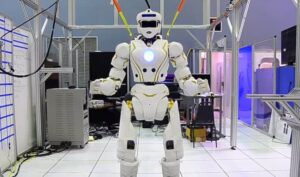NASA has announced that it has awarded prototypes of its R5 humanoid robot to two universities for advanced research and development work. Through these partnerships, NASA hopes to develop humanoid robots that can help or even take the place of astronauts working in extreme space environments.
Robots, like NASA’s R5, could be used in future NASA missions either as precursor robots performing mission tasks before humans arrive or as human-assistive robots actively collaborating with the human crew. R5 initially was designed to complete disaster-relief maneuvers, however, its main goal is to prove itself worthy of even trickier terrain – deep space exploration.
“Advances in robotics, including human-robotic collaboration, are critical to developing the capabilities required for our journey to Mars,” said Steve Jurczyk, associate administrator for the Space Technology Mission Directorate (STMD) at NASA Headquarters in Washington. “We are excited to engage these university research groups to help NASA with this next big step in robotics technology development.”
The two university proposals selected are:
- Robust Autonomy for Extreme Space Environments: Hosting R5 at Massachusetts Institute of Technology in Cambridge, Massachusetts, led by principal investigator Russ Tedrake
- Accessible Testing on Humanoid-Robot-R5 and Evaluation of NASA Administered (ATHENA) Space Robotics Challenge – Northeastern University in Boston, Massachusetts, led by principal investigator Taskin Padir
The two university groups were chosen through a competitive selection process from groups entered in the Defense Advanced Research Projects Agency (DARPA) Robotics Challenge. They also will receive as much as $250,000 a year for two years and have access to onsite and virtual technical support from NASA. STMD’s Game Changing Development Program, which is charged with rapidly maturing innovative technologies that will one day change the way NASA explores space, is funding the research.
The university principal investigators will serve as critical partners in NASA’s upcoming Space Robotics Challenge where the two R5 units will act as instruments. The challenge is part of the agency’s Centennial Challenges Program, and is divided into two competitions: a virtual competition using robotic simulations, and a physical competition using the two upgraded R5 robots. The goal of the challenge is to create better software for dexterous humanoid robots used in space missions, giving them more autonomy.
NASA’s Langley Research Center in Hampton, Virginia, manages the Game Changing Development Program for NASA’s Space Technology Mission Directorate. The Space Technology Mission Directorate is responsible for developing the cross-cutting, pioneering, new technologies and capabilities needed by the agency to achieve its current and future missions.



















